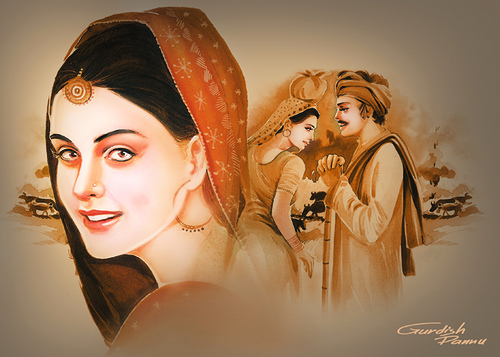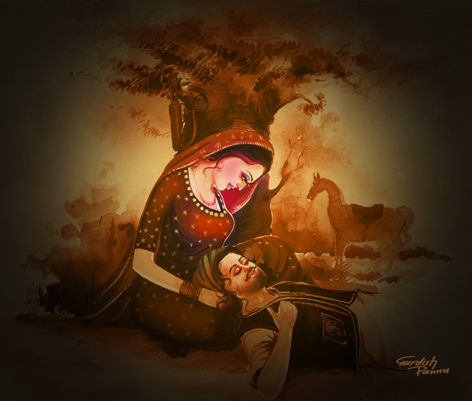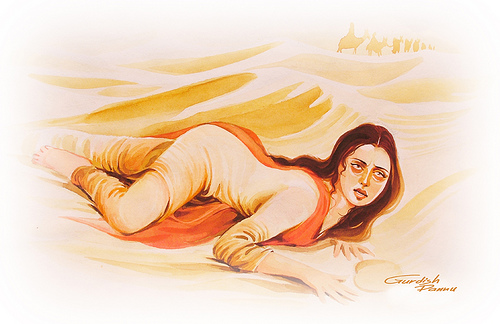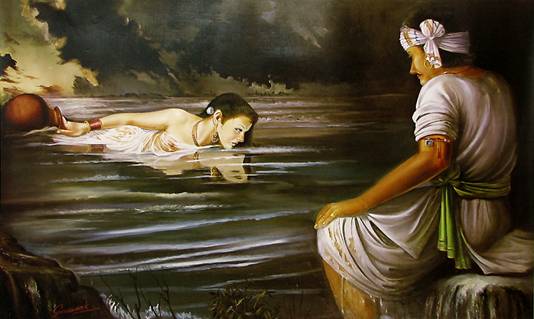 |
| Punjabi Folklore |
|
|
|
Punjabi Folklore The Punjab region, populated by Indo-Aryan speaking peoples, has been ruled by many different empires and ethnic groups, including Hindus, Jains, Buddhists, ancient Macedonians, Persians, Arabs, Turks, Mughals, Afghans, Balochis, Sikhs and British. The main religions of the Punjab region are Sikhism, Islam and Hinduism. Romantic TragediesThe heroines of Punjabi folk tales do not pine away, but rebel against the conventional norms of society and sacrifice everything for love. There are four popular tragic romances of the Punjab: Heer Ranjha, Mirza Sahiba, Sassi Punnun, and Sohni Mahiwal. These folktales immortalize and enshrine mortal love as the spirit of divine love. The poet Waris Shah, who versified the tale of Heer Ranjha, elevated mortal love to the same level as spiritual love for God. The tales also portray a double standard of moral and social convictions and the supremacy of love and loyalty. The protagonists are punished with death for flouting social conventions and disobeying their parents, yet their deaths are glorified and offerings are made at their tombs by those who seek blessings and redemption from suffering and unfulfilled desires. *****************************
Heer Ranjha (Punjabi: ਹੀਰ ਰਾਂਝਾ, ہیر رانجھا, hīr rāñjhā): Heer is the beautiful daughter of a wealthy Jatt family in Jhang. Ranjha, the youngest of four brothers, is his father's favorite son and leads a life of ease playing the flute ('Wanjhli'/'Bansuri'). Ranjha leaves home after a quarrel with his brothers over land, and travels to Heer's village where he is offered a job as caretaker of her father's cattle. Heer becomes mesmerized by Ranjha’s flute playing; the two fall in love and meet secretly for many years until they are caught by Heer's jealous uncle, Kaido, and her parents. Heer is engaged to marry another man, and the heartbroken Ranjha becomes a Jogi. piercing his ears and renouncing the material world. On his travels around the Punjab, Ranjha is eventually reunited with Heer, and her parents agree to their marriage. On the wedding day, Heer's jealous uncle poisons her food; Ranjha rushes to her side, takes the poisoned Laddu (sweet) which Heer has eaten and dies by her side. It is believed that the folktale originally had a happy ending, but that the poet Waris Shah (1706–1798) made it a tragedy. Heer and Ranjha are buried in a Punjabi town in Pakistan called Jhang, Punjab, where lovers and frequently visit their mausoleum. *****************************
Mirza Sahiba (Punjabi: ਿਮਰਜ਼ਾ ਸਾਹਿਬਾਂ, مرزا صاحباں, mirzā sāhibāṁ): Mirza and Sahiban are cousins who fall in love when Mirza is sent to Sahiban’s town to study. Sahiban’s parents disapprove of the match and arrange her marriage to Tahar Khan. Sahiban sends a taunting message to Mirza in his village, Danabad, "You must come and decorate Sahiban’s hand with the marriage henna." Mirza arrives on his horse, Bakki, the night before the wedding and secretly carries Sahiba away, planning to elope. Sahiba's brothers follow and catch up with them as Mirza is resting in the shade of a tree. Knowing that Mirza is a good marksman who will surely kill her brothers, and confident that her brothers will forgive and accept him when they see her, Sahiba breaks all Mirza’s arrows before she wakes him up. Her brothers attack Mirza and kill him, and Sahiban takes a sword and kills herself. *****************************
Sassui Punnun (or Sassui Panhu or Sassui Punhun) (Urdu: سسی پنوں; Sindhi: سسئي پنھون; Hindi: सस्सी-पुन्हू;Punjabi Gurmukhi: ਸੱਸੀ ਪੁੰਨ੍ਹੂੰ) is one of the seven popular tragic romances of the Sindh as well as one of the four most popular in Punjab. When Sassui, the daughter of the King of Bhambour, is born, astrologers predicted that she will be a curse for the royal family. The Queen orders the child to be put in a wooden box and thrown in the Indus River. A washerman of the Bhambour village finds the wooden box and adopts the child. Punnun is the son of King Mir Hoth Khan, Khan of Kicham (Kech). Stories of Sassui’s beauty reach Punnun and he becomes desperate to meet her. He travels to Bhambour and sends his clothes to Sassui's father to be washed so that he can catch a glimpse of her. Sassui and Punnun fall in love at first sight. Sassui's father agrees to the marriage, but Punnun’s father and brothers are opposed. Punnun's brothers travel to Bhambhor, kidnap Punnun on his wedding night and return to their hometown of Kicham. The next morning, Sassui, mad with the grief at being separated from her lover, runs barefoot across the desert towards the town of Kicham. On the way she is threatened by a shepherd and prays to God to hide her. The mountains open up and swallow her. Punnun, running back to Bhambhor, hears the story from the shepherd and utters the same prayer. The land splits again and he is buried in the same mountain valley as Sassui. The legendary grave still exists in this valley. Shah Abdul Latif Bhittai (1689–1752) retold this tale in his Sufi poetry as an example of eternal love and union with the Divine. *****************************
Sohni Mahiwal is also popular in Sindh and across South Asia. It is one of the most prominent examples of medieval poetic legends in the Punjabi and Sindhi languages. Sohni is the daughter of a potter named Tula, who lives in Gujrat on the caravan trade route between Bukhara and Delhi.[11]She draws floral designs on her father’s 'surahis' (water pitchers) and mugs and transform them into masterpieces of art. Izzat Baig, a wealthy trader from Bukhara (Uzbekistan), is completely enchanted when he sees the beautiful Sohni and sends his companions away without him. He takes a job as a servant in the house of Tula, and Sohni falls in love with him. When they hear rumors about the love of Sohni and Mahiwal, Sohni’s parents arrange her marriage with another potter without her knowledge. His "barat" (marriage party) arrives at her house unannounced and her parents bundle her off in the doli (palanquin). Izzat Baig renounces the world and lives like a "faqir" (hermit) in a small hut across the river. Each night Sohni comes to the riverside and Izzat Baig swims across the river to meet her. When he is injured and cannot swim, Sohni begins swimming across the river each night, using a large earthenware pitcher as a float. Her husband’s sister follows her and discovers the hiding place where Sohni keeps her earthen pitcher among the bushes. The next day, the sister-in-law replaces the pitcher with an unbaked one which dissolves in the water. Sohni drowns in the river; when Mahiwal sees this from the other side of the river, he jumps into the river and drowns with her. According to the legend, the bodies of Sohni and Mahiwal were recovered from river Indus near Shahdapur and are buried there. RiddlesPunjabis enjoy posing riddles and metaphorical questions as entertainment and as a measure of a person’s wit and intellectual capacity. Riddle competitions are mentioned in many Punjab folk-tales. It was once a common practice at weddings to assess the bridegroom’s intellect by posing riddles. Source: Newwrolldencyclopedi.org , http://www.newworldencyclopedia.org/entry/Pakistani_folklore |



